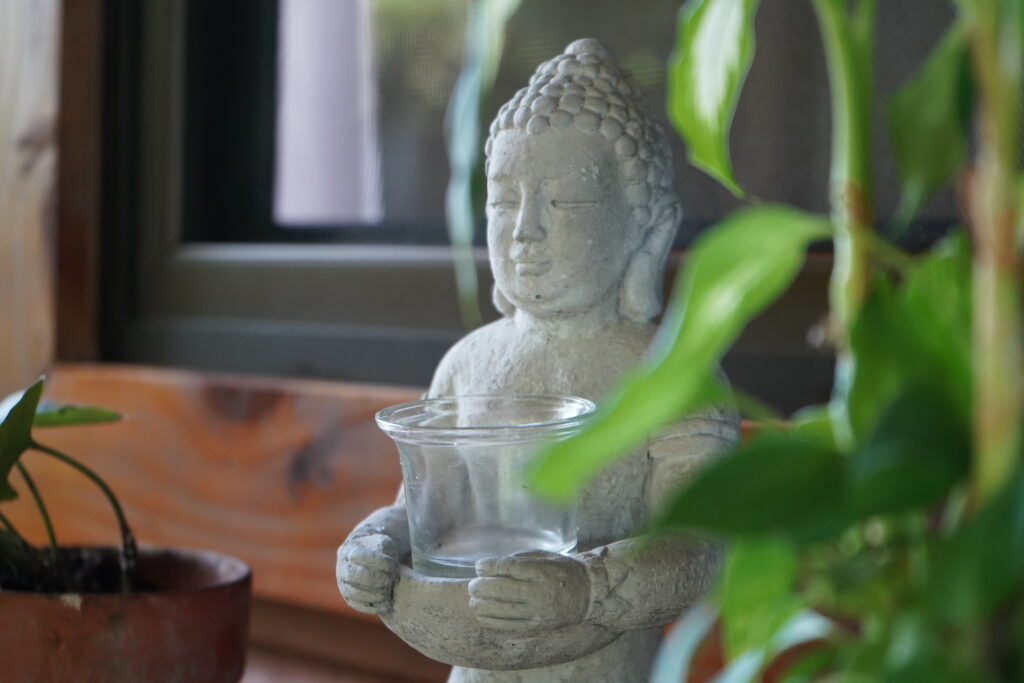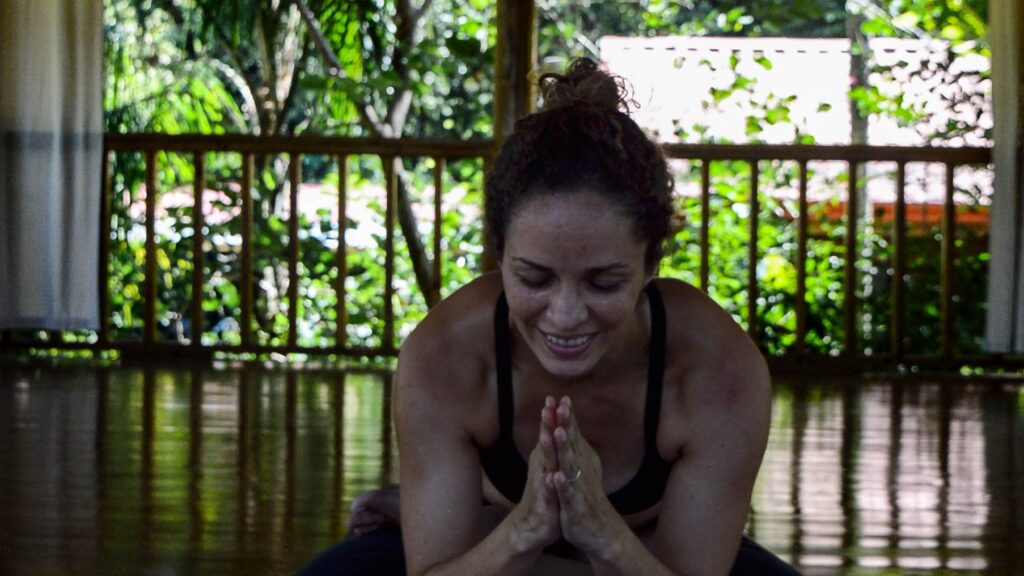From the steady buzz of our smartphones to the bright city lights on every corner, there are days when it feels like we’re constantly flooded with sensory inputs.
Without our control, our senses seem to be always engaged with someone or something, often leaving us feeling stressed or overwhelmed. That’s why many of us choose yoga as it helps pave a path to peace in the middle of this chaos.
One key element, in particular, Pratyahara, the fifth limb of the eight limbs of yoga, is the one that can teach you how to withdraw your senses from outward distractions.
Today, I’ll help you understand the basics of Pratyahara, how to reconnect with your inner self and find balance through the withdrawal of the senses.
Pratyahara: Beyond The Senses
The first four limbs of the 8 Limbs of Yoga include moral principles, daily practices, physical postures, and breathing practices. Yogis turn their attention inwards after these four foundational limbs are well cultivated.
The final four limbs focus on consciousness, mental concentration, meditation, and finally, enlightened states.
Together, all eight limbs represent a process of reflection, cultivating insight into who we are, and staying mindful of what’s essential in life. It connects the mind, body, breath, and higher self.
Pratyahara is the fifth limb of the eightfold path of Ashtanga. It represents a withdrawal of the senses by removing attachments to sensory stimulation.

What Does Pratyahara Mean?
In a sense, Pratyahara is nothing more than a tool that enables us to stop and look at the inner workings of our minds.
It doesn’t mean removing or ignoring all distractions. Instead, it’s a practice for observing and finding control over our senses so they don’t hold as much power as they usually would.
Practicing non-attachment becomes more manageable when we know the first four limbs of Ashtanga (Yama, Niyama, Asana, and Pranayama).
Through Asana and Pranayama, we purify our bodies and minds until cravings and attachments are more manageable to resist.
Pratyahara is a process of continuous observation of the senses, including our impulses and cravings. Then, it’s the practice of letting go.
This process deepens our understanding of the nature of happiness and sadness and helps us understand how temporary both states are. It also helps us comprehend all of our emotions and impulses.
Ultimately, we’ll be able to love the people we love in a way that makes them feel free, and we, too, will feel free. This makes the dedication and practice worthwhile.
Holding on to sensations will only disturb our inner peace. Instead, if we conserve that energy for something beneficial, we can free ourselves and the people around us.
Guided Yoga Nidra: Full Body Relaxation | Yoga with Pilar
Benefits of practicing Pratyahara
There are several benefits to practicing Pratyahara including the following:
- Unwinds The Mind: Through Pratyahara, you can relax and calm your thoughts without the need for external stimuli like TV or your smartphone.
- Decompresses The Body: With constant practice, you’ll feel your body release stress and tension over time, leaving you feeling more peaceful.
- Delays Reaction Time: Pratyahara allows you to pause and consider your actions and words, leading to a more thoughtful reaction.
- Improves Happiness: Because your need for external stimuli lessens, you’ll soon find other sources for your happiness and peace within yourself.
- Reduces ImpulsiveEmotions: Instead of getting alarmed or losing your balance upon hearing any type of news, Pratyahara allows you better control over your emotions.
- Promotes Physical and Mental Resilience: With constant practice, you’ll find yourself handling daily challenges, whether they’re physical or mental, with more ease.

What to Do When You’re Stuck in a World of Constant Stimulation?
Practicing sensory withdrawal and non-attachment can take many forms in the modern world. According to Pratyahara, outside validation is the wrong path as it’ll leave us depleted and unfulfilled!
Most people crave constant stimulation from their relationships with others. We search for love, approval, respect, or acceptance. Sometimes, we are simply seeking validation via views and likes.
For others, it’s fame and notoriety. This external validation is a way of measuring our worth with the opinions of others.
We also cling to material possessions, constantly seeking newer, better, nicer belongings. This manifests as searching Pinterest or Instagram for fancy homes or clothes.
It includes mindless online shopping meanwhile, closets and pantries are full. For others, it means garages or storage containers full of unused tools, toys, and gadgets. It takes shape as hoarding clothes, shoes, purses, or cars.
While this type of consumption provides immediate satisfaction, the effects are only temporary. This behavior goes against the first two limbs of Yoga—Yamas and Niyamas.
Besides social and material attachments, there are also hidden sensory distractions that aren’t quite as clear as the previous ones.
Sensorial disturbances include constant television, podcasts, music, news, and other stimuli.

In this space, we must be careful about the types of impressions we take in. If we nourish our bodies with healthy food and exercise but poison our minds with the wrong impressions, our minds won’t be at peace.
When we are constantly desensitized, the mind becomes dull and confused about what’s real versus fantasy.
If images of sex, violence, and greed constantly fill the mind, what kind of effect will it have? When external stimuli constantly bombard us in this way, we expend unnecessary emotional energy. In short, we become drained.
Such mindless consumption causes emotional imbalances in the body and breeds stress and discontentment. To hide this discontentment, we use even more external stimuli to suppress the unwanted emotions and the cycle repeats itself.
Simply put, when our senses are tuned into the outside world, they reflect the same chaotic and nervous energy to us.
When we withdraw our senses inward, we give space for emotional energy to move freely within the body and mind. This allows the mind time to find balance and purify itself.
In this sense, we can start to think of Pratyahara as a type of mental purification, preparing ourselves for more profound levels of meditation.
Yoga Talk: Philosophy + Yoga Nidra for Stressful Times | E01 | Awakening Sessions with Pilar
Practical Ways to Practice Pratyahara Daily
Now that you know the benefits of Pratyahara and how it can vastly change your life’s perception and emotional control, it’s time to ask the real question: how to practice Pratyahara?
There are a few tricks that you can do daily that’ll help you achieve your goal. These practices include:
- Turn the TV off during meals and before bedtime. You could even skip TV for one night a week. Another option is to do a week-long TV cleanse. During this time, opt to read, cook, or do a visualization meditation. Notice how you feel.
- Listen to a podcast or audiobook without doing a secondary activity—just close your eyes and listen.
- Drive someplace without music or any other audio stimulation—focus on what you see. Notice if the drive is more or less pleasant.
- Eat an entire meal in silence—focus on the flavors of the food and the effort it took to bring the food to your plate.
- Skip dessert for a week. Notice the difference in your mood.
- Drink a cup of tea in complete mindfulness. Focus on the aroma, warmth, flavors, and bodily sensations.
- Do a digital detox—whatever that means for you and your life. It can mean removing Pinterest, Instagram, X, or other social media platforms or simply setting specific times during the day to avoid using any electronic device.
- Unfollow channels that invite violence, fear, sex, comparisons, or unwanted distractions.
- Practice a period of celibacy, sobriety, fasting, or any other version of sensory withdrawal.
- Next time you get the urge to shop online, opt for a bath or a walk around the garden.
- Practice Asana Yoga with your eyes closed. Avoid all judgments and comparisons with others.
- Avoid meaningless chatter and gossip—focus your words on what brings value to people’s lives.
- Practice silence. This can be for a brief moment once a day or during a particular activity—such as before eating or after paddling to the line-up.

Asana Poses for Pratyahara

1. Easy Pose—Sukhasana
This simple and comfortable seated posture is commonly used for meditation and Pranayama (breathwork) practices.
Start by finding a quiet and peaceful space where you can sit without any distractions. You can use a yoga mat or sit on a folded blanket, yoga block, pillow, or cushion to elevate your hips and provide support.
Now, imagine a string pulling you up from the top of your head, creating space between the vertebrae. Keep your shoulders relaxed and down, away from your ears.
For a more profound sense of inward focus, gently close your eyes. This helps to minimize external distractions and directs your attention inward.
Another option is to sit in front of a window and meditate on something natural, such as a nearby plant or a sunrise. However, I don’t recommend this approach as you’ll mostly find a car or someone passing by that can distract you. It depends entirely on where you live.
Take slow, deep breaths, allowing your breath to flow naturally. Feel the expansion of your abdomen as you inhale and the gentle release as you exhale.
Bring your awareness to your breath, using it as an anchor to stay present in the moment. With your eyes closed, focus on your breathing.
2. Mountain Pose—Tadasana
Stand tall with your feet hip-width apart and your toes pointing forward. Distribute your weight evenly on both feet, engaging the leg muscles and lifting your kneecaps.
Stretch your spine, tuck your tailbone slightly, and draw your shoulder blades back and down. Let your arms hang loose by your sides, with palms facing forward.
Direct your gaze inwards by closing your eyes, feel your weight shifting between the four corners of your feet, and breathe deeply.
Focus on evenly distributing weight between both feet, grounding through the feet, and engaging core muscles for better balance. Close your eyes for an added challenge, both balance-wise and mentally.

3. Child’s Pose—Balasana
This restorative and gentle yoga pose promotes relaxation, stress relief, and stretching of the back and hips.
This pose provides a natural sensory withdrawal by placing the head between the arms with the eyes gazing toward the mat. Allow your forehead to rest on the floor gently.
Close your eyes and take deep, slow breaths. As you inhale, feel your breath expand your back and sides.
As you exhale, allow your body to soften and sink deeper into the pose. Use your breath to cultivate a sense of relaxation as you surrender to gravity. Gently rock your head side to side, focusing on the third eye or Ajna chakra.

4. Seated Forward Fold—Paschimottanasana
This seated yoga pose stretches the entire backside of the body, including the hamstrings, calves, and spine.
Keep your spine stretched, and avoid rounding your back as you fold forward. If you have tight hamstrings or limited flexibility, you can modify the stretch by inviting a bend into your knees or using a folded blanket or a bolster under your knees for support.
You can also place several blocks under the forehead to support the head, staying in the pose for as long as it feels comfortable.
5. Corpse Pose—Shavasana
Lie on your back with your legs extended and arms by your sides, palms facing up. Close your eyes and let your body relax completely.
Bring awareness to your breath, allowing it to flow naturally without forcing any particular breathing method.
Let go of any tension in your body and surrender to stillness. Pay close attention to the mind as it wanders, and gently bring it back to the breath.
Shavasana is about mental balance and relaxation. It allows the mind to settle, reduces stress, and promotes a sense of inner calm and equilibrium. Lay in Shavasana for 5, 10, or 20 minutes to practice Pratyahara or sensory withdrawal.

A Guided Pratyahara Meditation
On your mat, come to a seated position with a straight spine. Relax your shoulders away from the ears. Pull the shoulder blades down the back and together towards the body’s midline.
Extend the crown of your head towards the sky. If this is uncomfortable, lay flat on the mat, legs extended long, and palms face up. Close your eyes.
Begin by becoming aware of your senses, one by one, starting with touch. Feel the points where your body meets the mat. Breathe deeply focusing on the sensation of pressure and temperature. Release any tension you find. Relax the muscles.
Become aware of the sounds around you. Here in Costa Rica, the air is alive and full of sound 24/7, providing constant auditory stimulation.
Most times, it’s pleasant, birds singing, crickets chirping, rain pattering. At other times, it’s the sound of dogs fighting, metal grinding, trucks braking, or hammers pounding.
Likewise, if you practice in a city or near your children, let the sounds guide your practice. Focus on every sound you can hear. Discover the sound quality by noticing the body’s volume, frequency, and sensation. Breathe deeply and let it go.
Notice any smells wafting into your nose or tastes arising in your mouth. Relax your eyes and the muscles around the jaw. Relax the tongue and palate. Notice the sensations. Transition to notice the light, keeping your eyes closed.
The room may be bright or dark, with passing shadows or colors. Relax the eyelids and breathe.
When we slow down and observe the five senses in stillness and with mindfulness, we appreciate the immense stimuli already around us.
The next time you need a moment to relax, let this Pratyahara meditation guide you inward.
Frequently Asked Questions
To better understand yogis’ experience with Pratyahara, let’s explore some common questions they have:
What Is the Best Example of Pratyahara?
The best example you can get of Pratyahara is actually sleep. When you’re asleep none of your senses tend to the outside world and your mind is turned inward, to a land of dreams and, hopefully, peace.
This is where your true self is free from the constant barrage of sensory input—a natural withdrawal of the senses.
What Does Pratyahara Mean in Sanskrit?
The word Pratyahara is derived from two different words in Sanskrit: prati and aahara. The first word prati is actually a preposition that means towards something.
The latter means gathering. When put together, they form the concept of “drawing something in” or “gathering towards oneself.”
When discussing yoga, Pratyahara means withdrawing the senses from external objects and redirecting them inward.
What Is the Difference Between Pratyahara and Pranayama?
In simple terms, Pranayama is a step you go through first to prepare for Pratyahara. Pranayama is the practice of breath control, which helps calm your mind and relax your body.
Pratyahara, as I mentioned, is the practice of withdrawing your senses from the outside world and its stimuli. To conduct a proper Pratyahara practice, you must first achieve a state of calm and focus through Pranayama.
Resources
Jakubowicz, Rina. The Yoga Mind: 52 Essential Principles of Yoga Philosophy to Deepen Your Practice. Rockridge Press. Kindle Edition.
Thron, Raji. Mastering Vinyasa Yoga: The Yoga Synthesis Guide to Dynamic Sequencing with Hundreds of Photos and Instructions. Yoga Synthesis. Kindle Edition.

Your Journey Starts Here
Ready to Finally Experience That Life-Changing Surf + Yoga Trip (Without the Overwhelm)?
Bust the 5 biggest myths about going to a surf and yoga camp so you can stop procrastinating and start catching waves - with our FREE 5-day email course.
Change the heading on the Separator tab ->
Search
Get a Toolkit to Create Calm in Your Inbox
Watch the first lesson from our full immersive course: 8 Limbs of Ashtanga Yoga, FREE!
Change the heading on the Separator tab ->
Most Read Blogs
What is the Meaning of Anjali Mudra?
May 27, 2020
Fitness for Surfers: Workouts, Exercises & Training
February 10, 2022
The Best Places to Eat in Uvita, Costa Rica
May 19, 2022
How to Get From SJO to Costa Ballena, Costa Rica
May 31, 2018
Change the heading on the Separator tab ->
Categories
Categories
- Bodysurfing (5)
- Food (8)
- Responsible Business (6)
- Surfing (68)
- Travel (65)
- Yoga (44)
Change the heading on the Separator tab ->
Newsletter
Thanks for subscribing! Please check your email for further instructions.
Change the heading on the Separator tab ->
Follow Us
Carly Stoenner
Change the heading on the Separator tab ->
Read more
Ayurveda Series – Cooking with Prana
Words by Pilar
Welcome back! We’re thrilled that you’ve decided to join us as we dive into our third blog in Pilar’s discovering Ayurveda series – Cooking with Prana. Just to jog your memory, Pilar…
Agni – Ayurveda’s Most Vital and Dynamic Principle
Words by Pilar
What if we told you that you could change your life by reading just one blog post? While that might be a bit far fetched, we’re convinced that we could all benefit…
Intro to Ayurveda: Pilar’s Exploration into the Ancient Science of Longevity
Words by Pilar
If you’ve visited us recently and spent time with Pilar specifically — whether on the yoga mat or over breakfast, you’ve likely heard her mention the word “Ayurveda” multiple times. That’s no…



